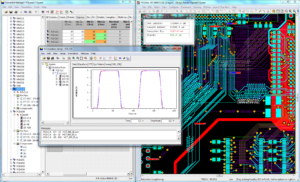 High-speed boards have been around for many years now and even though they are a fairly rare occurrence for most PCB design and engineering professionals, sooner or later you may have a high-speed PCB design project arrive on your desk. The question is, will you know how to deal with it? And what does a high-speed design even look like?
High-speed boards have been around for many years now and even though they are a fairly rare occurrence for most PCB design and engineering professionals, sooner or later you may have a high-speed PCB design project arrive on your desk. The question is, will you know how to deal with it? And what does a high-speed design even look like?
What does a High Speed PCB Design look like?
If the integrity of the signals is affected by things such as layout, packaging, layer stackup etc… then it is possible you are working on a high-speed design. The board will need to take into account the position of every processor, memory module and connector and determine the interconnect design between them.
The first time most designers will realise their board is high-speed is when they run into issues such as crosstalk, attenuation reflections and as a result it becomes more important to consider track placement, track widths, the proximity of other signals and the components being used.
Problems of High Speed PCB Design
When working on a high-speed PCB design, there are lots of issues that you can encounter. But for the moment lets focus on the top 3 most encountered.
- Are all of the signals on your PCB layout arriving at the same time? If timings are incorrect then it possible your board will be receiving corrupted data. The solution to this is having the proper impedance between the transmitter and receiver, which can directly affect the quality and integrity of the signals.
- Do your signals look as they should? If they don’t, then it means that your signal has possibly encountered interference that has ruined its integrity. These integrity issues are often as a result of electromagnetic radiation and Electromagnetic Interference (EMI) can create major issues for your design. The resolution to this, is to ensure the lengths of two coupled traces match and therefore arrive at the same time and in sync with clock rates.
- Do your signals experience interference from? All PCBs emit noise, but at higher frequencies this can adversely affect the operation of the circuit and increase the chance of corruption. Circuits that operate at frequencies in MHz range and higher and particularly susceptible. The closer the traces are to one another, the more likely they are to be affected. By not placing your traces closer than they need to be, you’ll reduce the amount of noise on your board.
Do you need High-Speed?
There is no specific definition of what classifies a PCB as high speed. If you’re encountering some signal integrity issues on your PCB layout, then that’s a good indication that you are dealing with a high speed project. If you’re designing a cell phone board, motherboard then you can be fairly certain to be working on a high-speed project especially if you need to incorporate specific technologies such as HDMI or USB onto your layout.
Not sure where to start with High-Speed?
Talk to the experts. Quadra regularly design high-speed boards for numerous customers with results our customers are happy with and we can also advise on the best software packages to deliver high-speed design.
Contact us for more information design@quadrasol.co.uk
For more information please contact us today!



